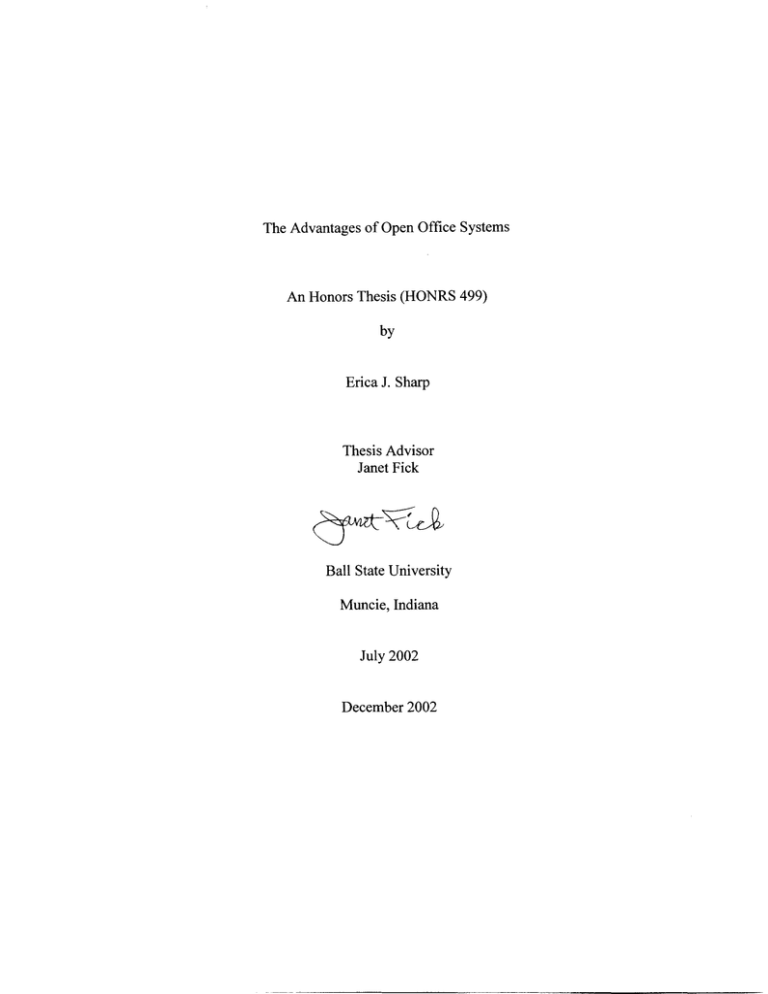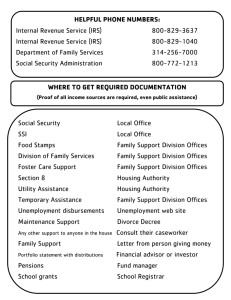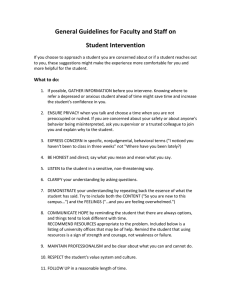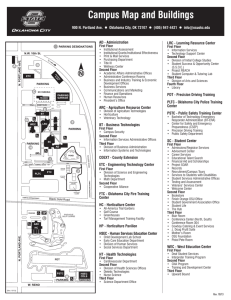The Advantages of Open Office Systems An Honors Thesis (HONRS 499) by
advertisement

The Advantages of Open Office Systems An Honors Thesis (HONRS 499) by Erica J. Sharp Thesis Advisor Janet Fick Ball State University Muncie, Indiana July 2002 December 2002 " ',J::> L-'I-f-c~_t, -/d- Abstract I utilized a space at the Ball State University Alumni Center and transformed it from private, t::nclosed offices to an open plan. My study begins with a written discussion of the advantages of open office systems. The second portion of the composition contains a col1ection of renderings produced using the Form-Z program and helps visually clarify the advantageous characteristics of an open plan office. Rationale Open office systems are becoming increasingly popular among both designers and office employees. I chose to discuss the advantages of such systems in both written and graphic form. After learning the 3-d rendering computer program Form-Z I have compiled a series of images featuring an open office space that I have designed. Throughout the completion of my thesis I have acquired valuable skills for future work in a design firm while also gaining a deeper understanding of the modem functioning office. Acknowledgements I would like to extend many thanks to my thesis advisor Janet Fick. Mrs. Fick gladly took the time to teach me a very complex program with both patience and enthusiasm. Her many praises along the way helped me reach the end of a difficult yet enlightening process. Thank you Mrs. Fick for your continual willingness to help. Open office planning has revolutionized the field of office design. Throughout past decades it has become clear to both designers and inhabitants of office spaces that physical surroundings deeply influence the work and the lives of those using the space. The rigid, pelmanent work settings of the past are being replaced by flexible, space saving office systems. An office that is composed of enclosed private offices with endless hallways and closed doors can be transitioned into a cleverly designed series of workspaces. Open planning creates a more aesthetically pleasing environment than does a closed space with a succession of private offices. With the diversity of office systems available today there are virtually no limits to the design possibilities. Spaces can be created with curves or can be kept strictly rectangular. The absence of walls allows for an open, expansive feel and helps eliminate the institutional atmosphere that is present in many office buildings. Because the basic structures of an open office system can be reused the system is very economical. The frames allow for panels to be easily replaced with various fabrics and therefore the furniture is supportive of, rather than competitive to, new interior appearances. The amount of space used with open offices is considerably less than that of private ones. Generally, an open workspace can be comfortably fit into a 7'x 7' space (49 square feet). Such an area would be unthinkable for an enclosed office. A small enclosed office would require approximately 120 square feet. This difference in space can allow an open office to better accommodate other amenities such as conference rooms, break rooms, lounges, etc. It also allows for more employees to be placed within a limited sized space. Open office systems are very elastic in the way in which they define space. Flexibility is a prime advantage of open planning. Using systems furniture allows the user to dismantle and reconstruct workspaces as desired. The systems can be transformed into new configurations in far less time than it would take to remove or build a single permanent wall. Such design flexibility can accommodate changing office environments (such as an increase or decrease in the number of employees or changing functions of a workspace). An open system can adapt to any office requirement to satisfy the needs of a modem workplace. There are numerous accessories available to customize individual workspaces. Rolling filing cabinets can be placed under desktops and can double as seats. Overhead storage can be placed over work surfaces. Other additions include coat racks, indirect work surface lighting, and dry-erase panels. Individuality is at the core of the open office. With the wide range of pieces available, each employee can personalize his or her space to provide for hislher particular work requirements while also catering to the individual's personal design preferences. An open office system allows its users to gain a sense of appreciation and possession in their workpla(;es. Such sentiments allow for more productive and satisfied employees. Another advantage of open office systems is the simplification in management of the direct working environment. Open systems make the workplace more enjoyable and productive. Members of management have a greater sense of control when they can easily observe employees at work. In a private office setting such indirect observation would be impossible. Communication among employees is also improved. In addition, open systems encourage the transaction of events, it becomes much easier for employees to work together and complete tasks. Although the open office may not be ideal for every business, the advantages can clearly be seen in thousands of offices across the globe. As offices continually become more technologically advanced it is imperative that the furniture systems and layouts of these offices can adapt to such changing environments. Design Description I have taken a space at the Ball State University Alumni Center and transformed it from a private office system to an open one. The newly designed space is to serve as an interior design office. By removing the majority of the space's interior walls a much more open and expansive feeling has been created. The initial space contained 12 small individual offices that were enclosed with permanent walls. There was one larger executive office and a conference room that was too small to be functional. Only one office (the executive office) was kept permanently enclosed and has been expanded to include a small meeting area. The conference room has been significantly enlarged and moved to a more pragmatic location near the entrance of the space. The formerly small and oddly shaped reception area has been moved and expanded to include a comfortable seating and display area. A curved desk and partition wall add great interest to the entrance area and will help clients form an exceptional first impression of the firm. Hanging glass sleeves behind the reception desk will display the firm's best works. A large workroom has been added to house all of the firm's printing and drafting equipment. A grouping of drafting tables will also be placed in this area. The former conference room has been converted into a storage area (due to its odd shape). The east side ofthe space now contains a large open area with configurations of systems furniture. The space, which originally housed five individual offices, is now comprised of nine workstations and a large portion of the resource room. The overall revised design of this office provides a much more communal working environment. Employees in such surroundings will be encouraged to work together. Areas such as the workroom and employee lounge provide employees with the opportunity to interact with one another. The transition from a private to an open office will most likely increase productivity and job satisfaction levels. Works Consulted Boje, Axel. Open-Plan Offices. London: Business Books Limited, 1968. Calmenson, Diane. "Open Office Defined." ISdesigNet. May 2000. http://www.isdesignet.com/Magazine/May·OO/berger.html Harris, David, et al. Planning and Designing the Office Environment. 2 nd ed. New York: Ban Nostrand Reinhold, 1991. Pile, John. Open Office Planning. New York: The Architectural Press, 1978. Saphier, Michael. Planning the New Office. New York: McGraw-Hill, 1978. .::J ., , '. or, " ." 4.-",l'o ~~~~ "".: , " - ..... '.... -. ,., " ""'~' -' "l '';, , ,· t'· , 'f " .,.,-- ", } ,,' ,I . .'. , " 'r ,/ -' -i! ;.fle "".i i ./ . '"" :; ;! .~ ": .; !.•,i , -.P'I .- ~., : ,i /, 1. ;, " ~ , ':. j " , l , , 1 "}, , ! ,. I, , I i l.: ,. " •! J " 1 , .J , , " I ·t ,< , ,; .' " i ,..,- t'i . , ... ;.J' .,' ,"



